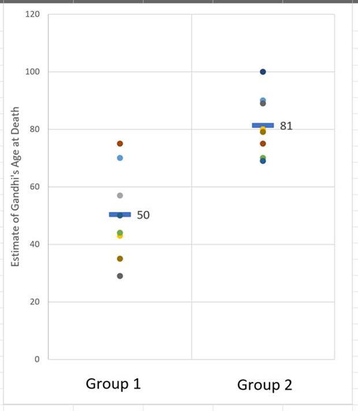Accurate and consistent forecasting of the time duration and cost of maintenance work order activities remains a challenging task for planners - despite being something they need to do every day.
Recently in one of IAMTech's training courses for software designed to increase forecasting accuracy using norms-based estimation, it was demonstrated how a cognitive bias called ‘anchoring' influences our estimating skills.
Cognitive bias
Attendees of the course were all planners or STO (Shutdown, Turnaround, Outage) managers for industrial plants, each with decades of experience. They were split into two groups, and each given the same question, with one important difference…
- Group 1 were asked, ‘Was Gandhi older or younger than 35 when he died? Guess his age.’
- Group 2 were asked the same question, only this time raising the age from 35 to a somewhat improbable 114!
The variation in results was astounding, with Group 1 having an average estimate of 50 years, whilst group 2 guessed 81 years.
The attendees were shown the results and asked why they thought their answers were so different. They concluded that it was because the question included one piece of varying information. The age.
That was the right answer.
“It turns out that our brains are very lazy and take shortcuts whenever possible, relying too much on an initial piece of information offered (called the “anchor”) to base future decisions and judgments on,” explains Jon Swift, training manager at IAMTech.
In this case, few of the attendees were likely to have much knowledge about Gandhi, so relied on the one piece of information they were given, the age. This heavily anchored the guesstimate, and whilst the age of 35 was too low, and 114 was too high, both significantly skewed the estimates.
This cognitive bias happens also happens in professional situations, where we are influenced by useful and perhaps not so useful information, even if we have a lot of experience.
The experiment was repeated this time using a more familiar topic for the group; estimating the time it would take to put up and dismantle a scaffold. Again, there were a range of estimates, even amongst these industry veterans.
It's important to be more data-driven when it comes to estimation. Software can remove anchoring, and avoids triggering the brain's lazy response, leading to standardization and consistent estimation. Such software stores historical estimates and the actual activity duration, even after project closure, so they can be reviewed and used for new work orders. This saves planning effort and makes the whole process more efficient and cost effective.
When using planning software, standard estimates can be saved as norms, meaning all staff can benefit from shared knowledge and practices. This enables accurate forecasting, and the ability to compare work orders, shutdowns, turnarounds and outages by reusing historical work orders. This results in a saving on planning effort, reduces costs, and leads to many other efficiencies.
Whilst IAMTech specialises in industrial asset management and risk solutions, the findings of this experiment are relevant for everyone that needs to make estimates and decisions, so essentially, everyone.
The bottom line is that as humans we are not always rational.
We are all guilty of relying too much on what we already know to make decisions, it is a human condition. Acknowledging this, and using technology to compensate will enable us to become better decisions makers, forecasters and planners.
How well did you do? Mohandas K (Mahatma) Gandhi was 78, when he was assassinated, in 1948






